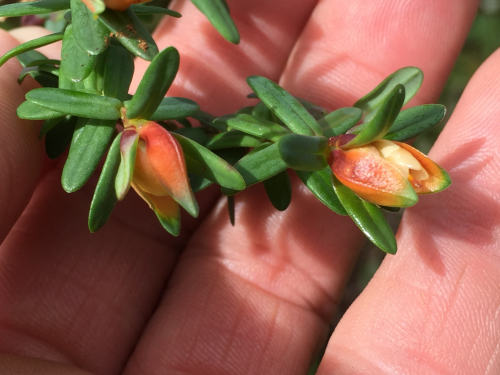#1749-1751 - Some SW Wildflowers
#1749 - Melaleuca thymoides - Sand Wattle Myrtle


A small shrub, endemic to to the SW, within roughly 100km of the coast. The binomial is derived from the foliage and its resemblance to Thyme, as noted when it was described in 1806 by the French biologist, Jacques Labillardière.
The plant grows in sand on granite hills and in areas that are flooded after rain - in this case, in the Ambergate Reserve south of Busselton. The flowers may appear between August and November.
As a myrtle, there’s a strong chance it will fall victim to the introduced fungal pathogen Myrtle Rust if it makes it from the eastern states to Western Australia. That would be bad.
#1750 - Melaleuca granitica - Granite Claw Flower


Formerly Calothamnus graniticus, until it got renamed in 2014. There’s two subspecies, both near-threatened, and since this one was growing in thin laterite soill over granite at Meelup Beach, this one was probably Melaleuca granitica granitica, the floral emblem of nearby Busselton. The flowers are usually bright red (sometimes cream), and sprout in clusters or irregular spikes containing 2 to 25 individual flowers, usually on old, leafless wood.
Quite an attractive shrub in warm, sunny gardens, growing well from seed and accepting pruning.
#1751 - Darwinia citriodora - Lemon-scented Darwinia


These two photos by me, at the headland above Meelup Beach, in a pile of heavily eroding granite boulders.

By Brett Montgomery - CC BY-SA 3.0, https://en.wikipedia.org/w/index.php?curid=24229640
Formally described in 1837 by Stefan Endlicher who gave it the name Genetyllis citriodora. The description was published in Enumeratio plantarum quas in Novae Hollandiæ ora austro-occidentali ad fluvium Cygnorum et in sinu Regis Georgii collegit Carolus Liber Baro de Hügel. You can probably translate the mention of the Swan River, and Baron Hugel, both of which I’ve mentioned before. King George Sound turns up in a lot of botantical descriptions from the period too. The Swan River, now the site of Perth, is about the north end of the range - it’s found in granite-derived soils in coastal areas from there to the Esperence Plain.
In 1865, George Bentham changed the name to Darwinia citriodora and published the change in Journal of the Linnean Society, Botany Named after the strong pleasant scent from the oil glands in the leaves, and Charles Darwin’s grandfather Erasmus. Genestylis I don’t know.
It makes quite a nice garden shrub, flowering from the middle of the year until October, and often over a wider span.